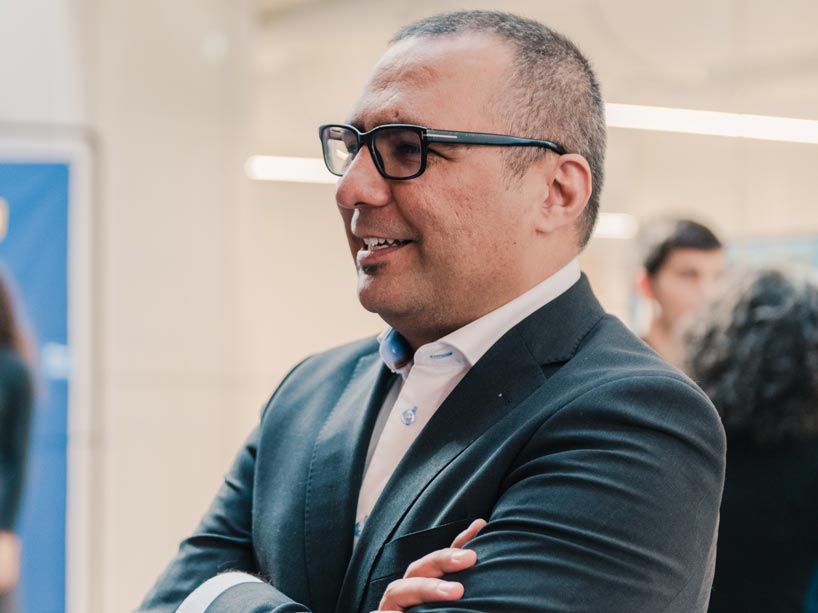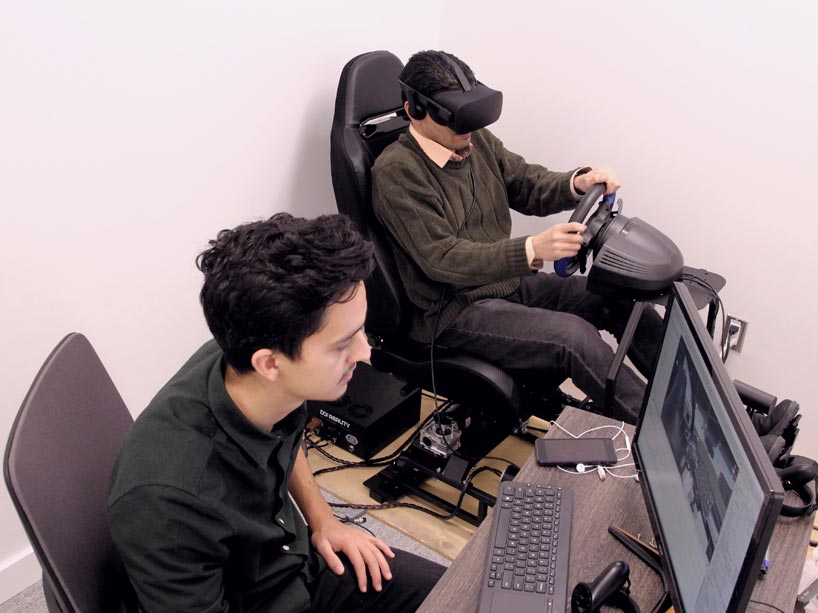Making transportation networks smarter

Researcher Bilal Farooq at the opening of the Centre for Urban Innovation earlier this year. Farooq’s LiTrans Lab is researching multi-modal, high level-of-service solutions for urban mobility. Photo Alyssa K. Faoro.
We’ve all been there: stuck in traffic when only blocks away, another route is flowing faster. We think, “I chose the wrong street (bus, train) again!” But it’s not your fault. According to what’s called queueing theory, the odds are against you choosing the optimal route every time.
What if a smart transportation network could take the guesswork out of travel? This is what guides engineer and Ryerson faculty member Bilal Farooq and his research into better transportation for our rapidly growing city and region.
Farooq, who joined Ryerson University in 2017, is the director of the Laboratory of Innovations in Transportation (external link) (LiTrans), situated in Ryerson’s Centre for Urban Innovation. There, he leads a team of researchers interested in multi-modal, high level-of-service solutions for urban mobility. One of their main interests is automated transportation, and the development of a connected traffic network plan to manage automated vehicles (AVs) when they inevitably become a reality in the GTA.
Preparing for AVs
“Automated vehicles are coming – in some cases, they’re already being piloted in nearby cities, as in the case of low-speed, public transportation vehicles with defined routes,” says Farooq. “But soon we’re going to start seeing a major push [by tech companies] to automate the next big transportation solution, which is on-demand.”
While Farooq understands that AVs are right around the corner, he says we’re far from being prepared for them.
“I’m a big fan of AVs. Greater automation has the potential to provide timely, reliable and frequent transportation to passengers. Just ask the TTC, which is currently upgrading its signals to automate its subway trains. But for AVs to work in a sustained and safe manner, connectivity and a smart network across the city is crucial. Currently we’re a long way off from implementing one.”
Advancing the concept of a connected transportation network, the LiTrans team at Ryerson is building on Farooq’s doctoral work, a complex simulation of a regional transportation system utilizing multiple data sets related to population, housing, employment and more. Using this data, they are simulating a downtown Toronto network with distributed intelligence: a system that will know the real-time traffic conditions, at all times, and route vehicles to maximize network throughput and efficiency and minimize GHG emissions.
“Today, our traffic conditions are uncertain – the system seems chaotic and uncontrolled, because we don’t have an exact idea of the state of the entire system at any point in time. Put automated vehicles into this system and they’ll just sit in traffic. With connectivity, we should be able to know how many vehicles are travelling, at what speed…everything we need to optimize the system, lessen route travel times, avoid congestion, minimize emissions, et cetera. And not just for AVs, but all vehicles.”
But while such a connected network could alleviate many of our current transportation woes and fully leverage the innovation of automated vehicles, it raises many issues to do with system adoption.
“The biggest challenge [to adoption] is definitely human behaviour. AVs have the potential to change the way we live, but their total impact on our choices is far from being understood. First, we need to understand how people are going to react to AVs, so that’s why we’ve developed our virtual reality framework.”
Virtual reality simulations
In a room in the LiTrans Lab sits a robotic chair with steering wheel. Subjects sit here while wearing a VR headset. Studio tech and Ryerson graduate student Raphael Vasquez is in charge of developing and running simulations that test people’s responses to situations in which they’re driving, using or encountering AVs, as if on our local streets.
“Our VR experiments show that drivers were more willing to give up control to AV when rich multi-tasking options, for example reading, watching videos or playing games, were available to them. In case of pedestrian and AV interactions, some participants, in particular kids, were taking advantage of the fact that AVs are always yielding for them and made them stop for longer than what time was required. If not addressed via proactive education and regulations, this behaviour may negatively affect the whole flow of the network in a real-world scenario.”

In the LiTrans lab, students run virtual reality simulations to test responses of people using automated vehicles. Photo courtesy City Building Institute.
Farooq is positive about the real-world application of his research. “Simulation research can answer what-if questions. For instance, we can test cost/benefit and equity outcomes before heavy investments are made. We’re also looking into new technologies like blockchain that could offer solutions to privacy and security questions raised by a connected network.”
With decision makers faced with the policy and infrastructure challenges raised by on-demand transport and automated vehicles, the research of the LiTrans Lab can provide valuable, reliable information to help reach informed decisions, and pave the way forward to the future of transportation.
Bilal Farooq will lead a tour of Ryerson’s Centre for Urban Innovation as part of the Smart Cities Summit (external link) on September 24. The CUI is a collaborative space for research, bringing students and faculty together to conduct research on alternative energy, water management, data analytics and smart urban infrastructure.
This story was provided by the City Building Institute.